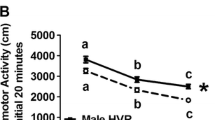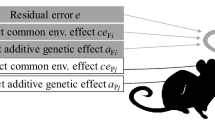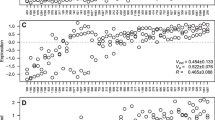Abstract
This study examined the day-to-day variability in voluntary wheel-running behavior among three genetically distinct lines of young male and female mice. Daily wheel revolutions were recorded at an age of 6–8 weeks in 10 males and 10 females from each of 3 lines: selectively bred line for high wheel running (Line 8), selectively bred for high wheel-running activity and fixed for a Mendelian recessive allele that reduces hind-limb muscle mass by 50% (Line 3), non-selected control (Line 2). There were significant mean differences in revolutions/day among weeks (P = 0.003), but the effect size was small (10%). Significant main effects for wheel running were also revealed for sex and line (P < 0.001). The grand mean ± SD for the coefficient of variation (CV) of intra-individual wheel running was 23.0 ± 10.8%. Although a significant main effect for the CV was found for week, the effect size was low (7%) (age 6 weeks, 23.4 ± 10.9%; age 7 weeks, 25.1 ± 13.2%; age 8 weeks, 20.1 ± 7.8%). The overall mean CV was similar between females (21.4 ± 9.8%) and males (24.4 ± 12.0%) and among lines (Line 2, 23.4 ± 9.8%; Line 3, 20.4 ± 7.6%; and Line 8, 25.0 ± 14.4%). These findings are consistent with our previous work in young humans and lend further support for the hypothesis that biological mechanisms influence daily levels of physical activity.

Similar content being viewed by others
References
Belke TW, Garland T Jr (2007) A brief opportunity to run does not function as a reinforcer for mice selected for high daily wheel-running rates. J Exp Anal Behav 88:199–213. doi:10.1901/jeab.2007.62-06
Black AE, Cole TJ (2000) Within- and between-subject variation in energy expenditure measured by the doubly-labelled water technique: implications for validating reported dietary energy intake. Eur J Clin Nutr 54:386–394. doi:10.1038/sj.ejcn.1600970
Friedman WA, Garland T Jr, Dohm MR (1992) Individual variation in locomotor behavior and maximal oxygen consumption in mice. Physiol Behav 52:97–104. doi:10.1016/0031-9384(92)90438-8
Garland T Jr, Morgan MT, Swallow JG, Rhodes JS, Girard I, Belter JG, Carter PA (2002) Evolution of a small-muscle polymorphism in lines of house mice selected for high activity levels. Evol Int J Org Evol 56:1267–1275. doi:10.1111/j.0014-3820.2002.tb01437.x
Girard I, McAleer MW, Rhodes JS, Garland T Jr (2001) Selection for high voluntary wheel running increases intermittency in house mice (Mus domesticus). J Exp Biol 204:4311–4320
Goran MI, Carpenter WH, Poehlman ET (1993) Total energy expenditure in 4- to 6-year-old children. Am J Physiol 264:E706–E711
Hannon RM, Kelly SA, Middleton KM, Kolb EM, Pomp D, Garland T Jr (2008) Phenotypic effects of the “mini-muscle” allele in a large HR × C57BL/6J mouse backcross. J Hered 99:349–354. doi:10.1093/jhered/esn011
Hartmann J, Garland T Jr, Hannon RM, Kelly SA, Muñoz G, Pomp D (2008) Fine mapping of “Mini-Muscle”, a recessive mutation causing reduced hind-limb muscle mass in mice. J Hered 99:679–687. doi:10.1093/jhered/esn040
Haugen HA, Melanson EL, Tran ZV, Kearney JT, Hill JO (2003) Variability of measured resting metabolic rate. Am J Clin Nutr 78:1141–1145
Iberall AS (1984) An illustration of the experimental range of variation of blood pressure. Am J Physiol 246(4 Pt 2):R516–R532
Keys A, Brozek J, Henschel A, Mickelson O, Anderson BL (1950) The biology of human starvation. University of Minnesota Press, Minneapolis
Koteja P, Swallow JG, Carter PA, Garland T Jr (2000) Individual variation and repeatability of maximum cold-induced energy assimilation in house mice. Acta Theriol (Warsz) 45:455–470
Malisch JL, Breuner CW, Kolb EM, Wada H, Hannon RM, Chappell MA, Middleton KM, Garland T Jr (2009) Behavioral despair and home-cage activity in mice with chronically elevated baseline corticosterone concentrations. Behav Genet 39:192–201. doi:10.1007/s10519-008-9246-8
Mattocks C, Leary S, Ness A, Deere K, Saunders J, Kirkby J, Blair SN, Tilling K, Riddoch C (2007) Intraindividual variation of objectively measured physical activity in children. Med Sci Sports Exerc 39:622–629. doi:10.1249/mss.0b013e318030631b
Middleton KM, Kelly SA, Garland T Jr (2008) Selective breeding as a tool to probe skeletal response to high voluntary locomotor activity in mice. Integr Comp Biol 48:394–410. doi:10.1093/icb/icn057
Morgan TJ, Garland T Jr, Carter PA (2003) Ontogenies in mice selected for high voluntary wheel-running activity. I. Mean ontogenies. Evol Int J Org Evol 57:646–657
Novak CM, Levine JA (2007) Central neural and endocrine mechanisms of non-exercise activity thermogenesis and their potential impact on obesity. J Neuroendocrinol 19:923–934. doi:10.1111/j.1365-2826.2007.01606.x
Rezende EL, Gomes FR, Chappell MA Garland T Jr (2009) Running behavior and its energy cost in mice selectively bred for high voluntary locomotor activity. Physiol Biochem Zool (in press)
Rhodes JS, Garland T Jr, Gammie SC (2003) Patterns of brain activity associated with variation in voluntary wheel-running behavior. Behav Neurosci 117:1243–1256. doi:10.1037/0735-7044.117.6.1243
Rhodes JS, Gammie SC, Garland T Jr (2005) Neurobiology of mice selected for high voluntary wheel-running activity. Integr Comp Biol 45:438–455. doi:10.1093/icb/45.3.438
Rowland TW (1998) The biological basis of physical activity. Med Sci Sports Exerc 30:392–399. doi:10.1097/00005768-199803000-00009
Sallis JF (2000) Age-related decline in physical activity: a synthesis of human and animal studies. Med Sci Sports Exerc 32:1598–1600. doi:10.1097/00005768-200009000-00012
Sallis JF, Prochaska JJ, Taylor WC (2000) A review of correlates of physical activity of children and adolescents. Med Sci Sports Exerc 32:963–975. doi:10.1097/00005768-200005000-00014
Swallow JG, Carter PA, Garland T Jr (1998) Artificial selection for increased wheel-running behavior in house mice. Behav Genet 28:227–237. doi:10.1023/A:1021479331779
Swallow JG, Koteja P, Carter PA, Garland T Jr (1999) Artificial selection for increased wheel running activity in house mice results in decreased body mass at maturity. J Exp Biol 202:2513–2520
Tanner JM (1962) Growth at adolescence. Blackwell, Oxford
Thorburn AW, Proietto J (2000) Biological determinants of spontaneous physical activity. Obes Rev 1:87–94. doi:10.1046/j.1467-789x.2000.00018.x
Vaanholt LM, Jonas I, Doornbos M, Schubert KA, Nyakas C, Garland T Jr, Visser GH, van Dijk G (2008) Responses in energy balance to high-fat feeding in mice selectively bred for high wheel-running activity. Int J Obes 32:1566–1575. doi:10.1038/ijo.2008.136
Westerterp KR, Speakman JR (2008) Physical activity energy expenditure has not declined since the 1980s and matches energy expenditures of wild mammals. Int J Obes 32:1256–1263. doi:10.1038/ijo.2008.74
Wickel EE, Eisenmann JC (2006) Within- and between-individual variability in estimated energy expenditure and habitual physical activity among young adults. Eur J Clin Nutr 60:538–544. doi:10.1038/sj.ejcn.1602348
Wickel EE, Eisenmann JC (2007a) Contribution of youth sports to total daily physical activity among 6- to 12-year-old boys. Med Sci Sports Exerc 39:1493–1500. doi:10.1249/mss.0b013e318093f56a
Wickel EE, Eisenmann JC (2007b) Maturity-associated variation in physical activity among 13 and 14 year old adolescents. Pediatr Exerc Sci 9:384–392
Wickel EE, Eisenmann JC, Pangrazi RP, Vincent SD, Raustorp A, Tomson LM, Cuddihy TF (2007) Do children take the same number of steps every day? Am J Hum Biol 19:537–543. doi:10.1002/ajhb.20613
Wilkin TJ, Mallam KM, Metcalf BS, Jeffery AN, Voss LD (2006) Variation in physical activity lies with the child, not his environment: evidence for an ‘activitystat’ in young children (EarlyBird 16). Int J Obes 30:1050–1055. doi:10.1038/sj.ijo.0803331
Acknowledgments
This work was supported by NSF grant IOB-0543429 to T.G. and NIH National Institute of Arthritis and Musculoskeletal and Skin Diseases grant 1F32AR053008-01 to K.M.M.
Author information
Authors and Affiliations
Corresponding author
Rights and permissions
About this article
Cite this article
Eisenmann, J.C., Wickel, E.E., Kelly, S.A. et al. Day-to-day variability in voluntary wheel running among genetically differentiated lines of mice that vary in activity level. Eur J Appl Physiol 106, 613–619 (2009). https://doi.org/10.1007/s00421-009-1056-z
Accepted:
Published:
Issue Date:
DOI: https://doi.org/10.1007/s00421-009-1056-z




